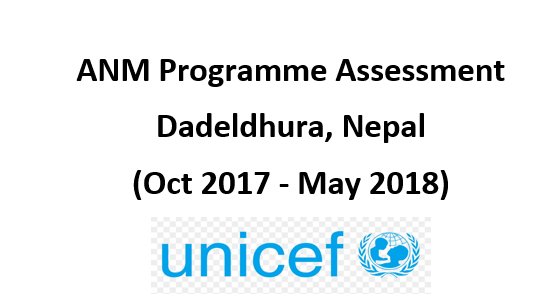ANM Programme Assessment, Dadeldhura, Nepal (Oct 2017 – May 2018)
October 2017- May 2018

-
Nepal’s gain in children’s and women’s health has been outstanding in spite of 10 years of armed conflict, low socioeconomic condition and a most challenging terrain. Apart from meeting MDGs, one example of the impressive progress was improvement in the rates of skilled birth attendance which rose significantly from 19% in 2006 to 56% in 2014. Yet, disparities are conspicuously visible when data are disaggregated showing high rates of maternal and neonatal mortalities in low income groups, hard to reach and socially disadvantaged communities. SBA coverage ranged from 20% in Mid-Western Mountain to 75% in Central Hills and only 25% of deliveries among women living in the poorest wealth quintile were assisted by skilled birth attendant. Other indicators such as coverage of antenatal and postnatal care and newborn mortality exhibit similar pattern. Earlier researches have already suggested that distance to health facility, inadequate transportation, lack of information about the availability of services in health facilities, and shyness and fear of hospital delivery remain major barriers in the decision to seek maternal and newborn health services.
In this backdrop, the Ministry of Health has initiated several programs to encourage women from the lowest quintile to utilize available services such as Aama program (free delivery with transport incentive), incentive for update of 4 ANCs, and NyanoJhola (mother and newborn package) but the service coverage among the targeted group had remained low. Therefore, to address these bottlenecks, Family Heath Division (FHD) had launched a pilot program “the community Auxiliary Nurse Midwife (ANM) program” in Dadeldhura district in 2013/14, which aimed to provide quality services on mothers’ and newborns’ doorstep to bridge gaps between health facilities and communities and contribute to reducing maternal and newborn mortality.
The program deployed one community ANM entrusted with the responsibility of three wards, thus 3 ANMs in one village development committee (VDC). A total of 60 ANMs were deployed in Dadeldhura district through the strict and transparent selection process. The key responsibilities of ANMs were assigned as follows:
- to conduct door-to-door survey in a catchment area and register local residents and pregnant women
- to deliver health education using birth preparedness package and other health counselling tools
- to encourage every pregnant woman to take up antenatal care at least four times and to have institutional delivery without delay
- to inform pregnant women of benefits of the AAMA program
After implementation, it is time to evaluate the program and to find out whether the objectives of the program were met. What were the successes, challenges, gaps and lessons learned during the program implementation? This implementation research is designed to find answers to these questions. Results of this assessment is expected to inform whether the program requires some adjustment to produce, deploy and sustain ANMs as per the objective of the program. This assessment is expected eventually to contribute to ensure the effective coverage of an agreed package of community health interventions for the target population including pregnant women, mothers, newborns, children and adolescents.
-
The objectives of the assessment are:
1. To examine whether the ANM programme reached the intended target group
2. To examine factors that affect client demand and utilization of health services provided by ANMs
3. To document the process in which ANM worked to improve utilization of services in health facilities and to strengthening community-based services such as ORC and EPI clinics
4. To analyse trends in service utilization for comparison of before and after the ANM programme
5. To analyse the current and long-term cost of the ANM programme;
6. To extract lesson learned and draw concrete recommendations that will guide the planning of successful expansion of the ANM programme.
-
UNICEF Nepal
-
Dadeldhura district
